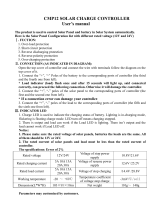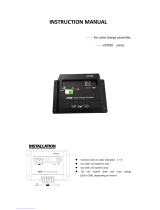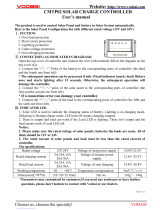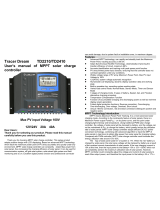Page is loading ...

Version 1.0
Rover 20A | 30A | 40A
Maximum Power Point Tracking Solar Charge Controller
Rover Series

General Safety Information
Charge Controller Safety
Important Safety Instructions
Please save these instructions.
This manual contains important safety, installation, and operating instructions for the charge
controller. The following symbols are used throughout the manual to indicate potentially
dangerous conditions or important safety information.
There are no serviceable parts for this controller. Do NOT disassemble or attempt to repair
the controller.
Make sure all connections going into and from the controller are tight.
NEVER connect the solar panel array to the controller without a battery. Battery must be
connected first.
Ensure input voltage does not exceed 100 VDC to prevent permanent damage. Use the
Open Circuit Voltage (Voc) to make sure the voltage does not exceed this value when
connecting panels together.
Read all of the instructions and cautions in the manual before beginning the installation.
Do
NOT
allow water to enter the controller.
Indicates a potentially dangerous condition. Use extreme caution
when performing this task
Indicates a critical procedure for safe and proper operation of the
controller
Indicates a procedure or function that is important to the safe and
proper operation of the controller

Battery Safety
Use only sealed lead-acid, flooded, gel or lithium batteries which
must be deep cycle.
Explosive battery gases may be present while charging. Be certain there is enough
ventilation to release the gases.
Be careful when working with large lead acid batteries. Wear eye protection and have
fresh water available in case there is contact with the battery acid.
Over-charging and excessive gas precipitation may damage the battery plates and
activate material shedding on them. Too high of an equalizing charge or too long of one
may cause damage. Please carefully review the specific requirements of the battery
used in the system.
Equalization is carried out only for non-sealed / vented/ flooded / wet cell lead acid
batteries.
Do
NOT
equalize VRLA type AGM / Gel / Lithium cell batteries UNLESS permitted by
battery manufacturer.
Default charging parameters in Li mode are programmed for 12.8V Lithium Iron
Phosphate (LFP) Battery only. Before using Rover to charge other types of lithium
battery, set the parameters according to the suggestions from battery manufacturer.
Carefully read battery manuals before operation.
Do
NOT
let the positive (+) and negative (-) terminals of the battery touch each other.
Connect battery terminals to the charge controller BEFORE connecting
the solar panel(s) to the charge controller. NEVER connect solar panels to
charge controller until the battery is connected.
Do NOT connect any inverters or battery charger into the load terminal of
the charge controller.
Once equalization is active in the battery charging, it will not exit this stage
unless there is adequate charging current from the solar panel. There
should be NO load on the batteries when in equalization charging stage.
Recycle battery when it is replaced.

Table of Contents
General Information
Additional Components
Optional Components
Identification of Parts
Operation
LED Indicators
Rover Protections
System Status Troubleshooting
Maintenance
Fusing
Technical Specifications
Electrical Parameters
Battery Charging Parameters
PV Power – Conversion Efficiency Curves
Dimensions
Installation
Error Codes
General

General Information
Customizable charging voltages
The MPPT Charge Controller utilizes Maximum Power Point Tracking technology to extract
maximum power from the solar module(s). The tracking algorithm is fully automatic and
does not require user adjustment. MPPT technology will track the array’smaximum power point
voltage (Vmp) as it varies with weather conditions, ensuring that the maximum power is
harvested from the array throughout the course of the day.
The Rover Series charge controllers are suitable for various off-grid solar applications. It protects
the battery from being over-charged by the solar modules and over-discharged by the loads. The
controller features a smart tracking algorithm that maximizes the energy from the solar PV module
(s) and charge the battery. At the same time, the low voltage disconnect function (LVD) will prevent
the battery from over discharging.
The Rover's charging process has been optimized for long battery life and improved system
performance. The comprehensive self-diagnostics and electronic protection functions can prevent
damage from installation mistakes or system faults.
In many cases, the MPPT charge controller will “boost” up the current in the solar system. The
current does not come out of thin air. Instead, the power generated in the solar panels is the
same power that is transmitted into the battery bank. Power is the product of Voltage (V) x
Amperage (A).
Automatically detect 12V or 24V DC system voltages
Deep cycle Sealed, Gel, Flooded and Lithium (12.8V LFP) battery option ready
Electronic protection: Overcharging, over-discharging, overload, and short circuit
Innovative MPPT technology with high tracking efficiency up to 99% and peak
conversion efficiency of 98%
Reverse protection: Any combination of solar module and battery, without causing
damage to any component
Charges over-discharged lithium batteries
RS232 port to communicate with BT-1 Bluetooth module and PC
MPPT Technology
Current Boost
Key Features

Therefore, assuming 100% efficiency:
Power In = Power Out
Volts In * Amps In = Volts out * Amps out
Maximum
Power Point
Traditional
Controller
Operating
Range
Maximum
Power Point
Although MPPT controllers are not 100% efficient, they are very close at about 92-95% efficient.
Therefore, when the user has a solar system whose Vmp is greater than the battery bank
voltage, then that potential difference is proportional to the current boost. The voltage generated
at the solar module needs to be stepped down to a rate that could charge the battery in a stable
fashion by which the amperage is boosted accordingly to the drop. It is entirely possible to have
a solar module generate 8 amps going into the charge controller and likewise have the charge
controller send 10 amps to the battery bank. This is the essence of the MPPT charge controllers
and their advantage over traditional charge controllers. In traditional charge controllers, that
stepped down voltage amount is wasted because the controller algorithm can only dissipate it
as heat. The following demonstrates a graphical point regarding the output of MPPT technology.
Temperature is a huge enemy of solar modules. As the environmental temperature
increases, the operating voltage (Vmp
) is reduced and limits the power generation of the solar
module. Despite the effectiveness of MPPT technology, the charging algorithm will
possibly
not have much to work with and therefore there is an inevitable decrease in
performance.
In this scenario, it would be preferred to have modules with higher nominal
voltage, so that
despite the drop in performance of the panel, the battery is still receiving
a current boost
because of the proportional drop in module voltage.
Limiting Effectiveness
Current vs. Voltage (12V System) Output Power(12V System)
Typical Battery
Voltage Range

The Rover MPPT charge controller has a 4-stage battery charging algorithm for a rapid,
efficient, and safe battery charging. They include: Bulk Charge, Boost Charge, Float Charge,
and Equalization.
Bulk Charge: This algorithm is used for day to day charging. It uses 100% of available solar
power to recharge the battery and is equivalent to constant current. In this stage the battery
voltage has not yet reached constant voltage (Equalize or Boost), the controller operates in
constant current mode, delivering its maximum current to the batteries (MPPT Charging) .
Float Charge: After the constant voltage stage, the controller will reduce the battery voltage
to a float voltage set point. Once the battery is fully charged, there will be no more chemical
reactions and all the charge current would turn into heat or gas. Because of this,
Constant Charging: When the battery reaches the constant voltage set point, the controller
will start to operate in constant charging mode, where it is no longer MPPT charging. The current
will drop gradually. This has two stages, equalize and boost and they are not carried out
constantly in a full charge process to avoid too much gas precipitation or overheating of the
battery.
Boost Charge:
Boost stage maintains a charge for 2 hours by default. The user
can adjust the constant time and preset value of boost per their demand.
Four Charging Stages

The charge controller will reduce the voltage charge to smaller quantity, while lightly charging
the battery. The purpose for this is to offset the power consumption while maintaining a full
battery storage capacity. In the event that a load drawn from the battery exceeds the charge
current, the controller will no longer be able to maintain the battery to a Float set point and the
controller will end the float charge stage and refer back to bulk charging.
The Rover MPPT charge controller has a reactivation feature to awaken a sleeping lithium
battery. The protection circuit of lithium battery will typically turn the battery off and make it
unusable if over-discharged. This can happen when storing a lithium battery pack in a
discharged state for any length of time as self-discharge would gradually deplete the remaining
charge. Without the wake-up feature to reactivate and recharge batteries, these batteries would
become unserviceable and the packs would be discarded. The Rover will apply a small charge
current to activate the protection circuit and if a correct cell voltage can be reached, it starts a
normal charge.
Equalization: Is carried out every 28 days of the month. It is intentional overcharging of
the battery for a controlled period of time. Certain types of batteries benefit from periodic
equalizing charge, which can stir the electrolyte, balance battery voltage and complete
chemical reaction. Equalizing charge increases the battery voltage, higher than the standard
complement voltage, which gasifies the battery electrolyte.
When using the Rover to charge a 24V lithium battery bank, set the system
voltage to 24V instead of auto recognition. If auto recognition is accidently
selected the Rover will allow you to change it to 24V when the lithium battery
activation feature is activated. In the activation interface press and hold the
enter button to trigger the system voltage selector. To change the system
voltage, press the Up or Down buttons then long press Enter to save the
selected system voltage.
Lithium Battery Activation
Once equalization is active in the battery charging, it will not exit this stage unless
there is adequate charging current from the solar panel. There should be NO load
on the batteries when in equalization charging stage.
Over-charging and excessive gas precipitation may damage the battery plates
and activate material shedding on them. Too high of equalizing charge or for too
long may cause damage. Please carefully review the specific requirements of the
battery used in the system.
Equalization may increase battery voltage to a level damaging to sensitive DC
loads. Ensure that all load allowable input voltages are greater than the equalizing
charging set point voltage.

Additional Components
Optional Components
Additional components included in the package:
Optional components that require a separate purchase:
This sensor measures the temperature at the battery and uses this data for
very accurate temperature compensation. Accurate temperature
compensation is important in ensuring proper battery charging regardless
of the temperature.
The BT-1 Bluetooth module is a great addition to any Renogy charge
controllers with a RS232 port and is used to pair charge controllers with the
Renogy BT App. After pairing is done you can monitor your system and
change parameters directly from you cell phone or tablet. No more
wondering how your system is performing, now you can see performance
in real time without the need of checking on the controller’s LCD.
Do Not use this sensor when charging lithium battery.
Renogy BT-1 Bluetooth Module:
Remote Temperature Sensor:

9 10 11
12
8
Key Parts
Identification of Parts
3
4
6
5
2
1
7
1. PV LED Indicator
2. Battery LED Indicator
3. Load LED Indicator
4. System Error LED Indicator
5. LCD Screen
6. Operating Keys
7. Mounting Holes
8. Remote Temperature Sensor Port (optional accessory)
9. PV Terminals
10. Battery Terminals
11. Load Terminals
12. RS-232 Port (optional accessory)

Installation
Connect battery terminal wires to the charge controller FIRST then connect the
solar panel(s) to the charge controller. NEVER connect solar panel to charge
controller before the battery.
Do NOT connect any inverters or battery chargers into the LOAD TERMINAL of
the charge controller.
Recommended tools to have before installation:
Screwdriver
INVERTER
BATTERY
CHARGER
HIGH AMP
DRAWING DEVICE
Do not over tighten the screw terminals. This could potentially break the
piece that holds the wire to the charge controller.
Refer to the technical specifications for max wire sizes on the controller and
for the maximum amperage going through wires.
You are now ready to begin connecting your battery to your charge controller.
Multi-Meter

Battery
3
1 2

Load (optional)
Solar Panels
1 2
1 2

Temperature Sensor (optional, not polarity sensitive)
PC or Bluetooth Module communication (optional)
Mounting Recommendations
Never install the controller in a sealed enclosure with flooded batteries. Gas can accumulate
and there is a risk of explosion.
1. Choose Mounting Location—place the controller on a vertical surface protected from
direct sunlight, high temperatures, and water. Make sure there is good ventilation.
1 2
3
1 2
Secure the Temperature Sensor lug to one of the battery posts
Do NOT place the Temperature Sensor lug inside the battery cell.

Operation
2. Check for Clearance—verify that there is sufficient room to run wires, as well as clearance
above and below the controller for ventilation. The clearance should be at least 6 inches (150mm).
3. Mark Holes
4. Drill Holes
5. Secure the charge controller.
Rover is very simple to use. Simply connect the batteries, and the controller will automatically
determine the battery voltage. The controller comes equipped with an LCD screen and 4 buttons
to maneuver though the menus.
Startup Interface

Main Display
Charging Current
Main Screen
Solar Panel Voltage
Error Code
Battery Voltage
Battery Capacity
Load Current
Accumulated AH
Load mode
Discharged AH
Ambient Temperature
The Battery Capacity (SOC%) is an estimation based on the charging voltage.

Page Down/ Decrease parameter value
Return to the previous menu
Enter sub menu/ save parameter value/
turn load on or off in manual mode
/
/
-
ENTER/
To enter the programming interface simply press and hold the right arrow button. After entering
this feature press the Enter/Right button to switch between parameters. To change the
parameters, press the Up or Down button. To save the parameter press and hold the
Enter/Right button.
The charging parameter setting (Equalizing voltage, Boost voltage, Floating charging voltage,
over-discharge return voltage, Over-discharge voltage) are only available under the battery
“USER” mode. Press and hold the right arrow to enter the programming settings and continue
pressing the right arrow button until you see the desired voltage screen.
Battery charging parameters can also be programmed using Solar Monitoring Software and
Renogy BT APP. Read the corresponding user manuals for more information.
Programming Parameters
Page Up/ Increase parameter value
Over-discharge voltage
Over-discharge
return voltage
Battery type System voltage Equalizing voltage boost voltage
Floating charging
voltage

Load Mode Options
1 2 3 4
Programming Load Terminal
1. This screen is displaying the current Load Mode.
2. To enter screen 2 press and hold t
he Enter button. This screen will allow you to change
the load mode.
3. To change the load mode press the up or down button.
4.
Once you have selected the desired load mode press the Enter button to save the setting.
5. To exit the programming setting press the left button.
Setting Mode Description
0 Automatic(On/Off)
Time control
15 Manual
16 Test
17
24Hr
The load will turn on at night when the solar
panel is no longer producing any power after
a short time delay. The load will turn off
when the panel starts producing power.
When the panel is no longer producing power
the load will be ON for 1-14 hours or until the
panel starts producing power.
Used to troubleshoot load terminal (No
Time Delay). When voltage is detected
load will be off and when no voltage is
detected load will be on.
In this mode, the user can turn the Load
On/Off by pressing the Enter button at
any time.
The load will be on for 24 hours a day.
1-14

LED Indicators
LCD Indicators
---PV array indicator
Indicating the controller's current
charging mode.
Indicating the battery's current state.
Indicating the loads' On/ Off state.
Indicating whether the controller is
functioning normally.
---BAT indicator
---LOAD indicator
---ERROR indicator
nighttime daytime solar panel charging
charging stage system voltage setting serial port bluetooth abnormality battery type unit
battery discharging load parameter value

Status
White
Solid
Off
The Controller is undergoing boost stage
The Controller is undergoing float stage
The Controller is undergoing equalization stage
Status
White Solid
Off
System Error. Please check LCD for Error code
Off
System is operating normally
Status
White Slow Flashing
White Single Flashing
White Fast Flashing
White Double Flashing
White Solid
White Fast Flashing
White Solid
White Fast Flashing
White Slow Flashing
Status
The PV system is charging the battery bank
The PV system is charging the battery bank at a
slow rate. Make sure panels are not shaded. Low
Amperage
The PV system is not charging the battery bank.
PV not detected.
Battery over-voltage
Battery over-discharged
Battery is normal
Load is on
Load is over-loaded or short-circuited
Load is off
BATT Indicator (3)
BATT Indicator (2)
BATT Indicator (4)
PV Indicator (1)
/




